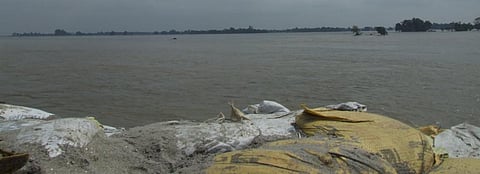

The Bihar government has said it has no plan to desilt the Kosi. The river, known as ‘Sorrow of Bihar’, overflows during rains, causing floods in several parts of the state.
Bihar water resources minister Sanjay Kumar Jha told the Bihar assembly on March 4, 2020: “The state government doesn’t have any plan to desilt the Kosi due to a lack of technique.”
He was replying to a call attention motion brought up by the ruling party’s lawmakers. They had asked the state government to send a proposal to Centre for a permanent solution to flooding.
The legislators had said a huge tract of farm land dissolved in the river due to breach of river embankments. They had sought a solution for the state’s annual flood fury.
The minister, however, pointed to a survey carried out on the Kosi barrage and said efforts had been made to plug the breaches. “It’s due to our alertness that the river has not breached its embankments in over a decade,” he told the assembly.
The Koshi runs for 729 km and drains an area of 74,500 km in Tibet, Nepal and Bihar. It carries 950 lakh cubic meters of sediment every year.
The last time the Kosi had caused extensive damage was in August 2008, when the river breached its mud embankments at Kusaha in Nepal. The river flowed through over 1,000 densely populated villages in five eastern Bihar districts: Supaul, Madhepura, Araria, Saharsa and Purnia for months. Over 500 people died and around four million were rendered homeless.
Around a million were evacuated and 400,000 had to be lodged in relief camps. More than 300,000 houses were destroyed and crops spread over at least 840,000 acres were damaged. The flood was declared as the “national calamity” by the Indian government.
The deluge — which the Bihar government described as the worst in half a century — also brought heavy layers of silt to the farm land, filling them with sand and stone dust. More than a decade on, villagers are still grappling with consequences.
According to experts, construction of embankments was the major reason behind the annual floods.
“Embankments were constructed to check floods, but it led to water-logging. It affected agricultural activities adversely,” activist Ranjeev Kumar said.
“Before the embankments, free flow of Kosi meant the silt got spread evenly. Now, the silt gets accumulated inside the river bed. This is worrisome. These embankments have caused flooded large areas of Kosi,” he added.
Experts described the current strategy as “outdated”. At a workshop held in Nepal in 2018, flood expert Dinesh Kumar Mishra sought a new strategy for flood control.
“The measures taken for flood control are not working anymore. There is a need to combine common man’s wisdom with skills of engineers. Unfortunately, both have contempt for each other,” Mishra, an IIT engineer-turned-river activist, said at the workshop on “Understanding a Transboundry Basin: The Case of the Kosi”.
According to Mishra, also a convener of non-profit Barh Mukti Abbhiyan, British experts were opposed to the construction of embankments.
“British engineers have reiterated that Koshi flood water was not a problem; sediment in the river was,” Mishra had said.